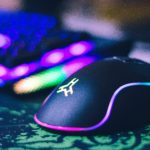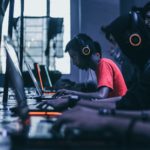In this article a quick overview of the research article “the structure of performance and training in esports” is given. The paper provides a different approach on performance in esports. The authors show that there is indeed a way to view and analyze esports from the perspective of traditional sports science. If you are interested in reading the full article which goes much deeper into the topic, provides detailed insight and processes even more research questions, please feel free to read it here.
Factors of esports performance
In the first step of the research, the authors create a performance-framework integrating insights from game research and sports science (Figure 1).
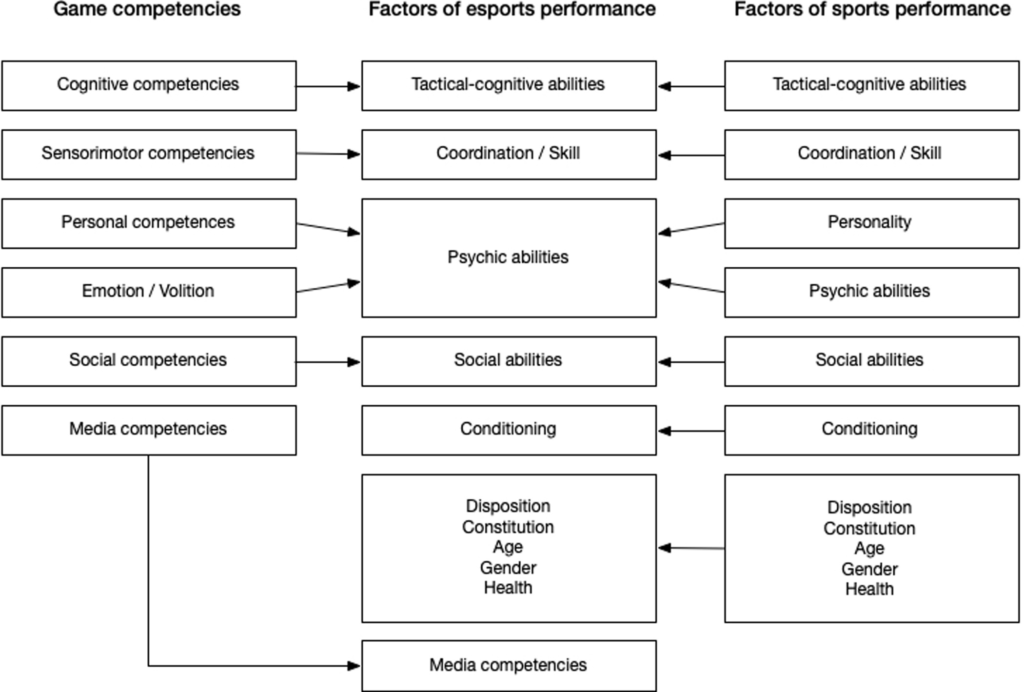
The framework derives 7 performance-factor-categories for esports (middle row of picture 1).
Tactical-cognitive abilities represent strategical thinking and decision making.
Coordination and skill stand for sensori-motor actions such as hand-mouse, finger-keyboard, hand-joystick interactions. Furthermore spatial orientation, reaction time, anticipation and synchronous and sequential coordination of movements play a big part in the overall skill of a player. In esports, situations change rapidly. Fast combination of movements and adaptation to new situations is a given for every successful esports player.
Psychic abilities describe the players mentality and the ability to cope with losses. Social abilities are qualities to work or fit within a team.
Conditioning characterizes global aerobic endurance, local anaerobic-alactacide endurance as well as selected speed abilities, as players not only have to move quickly according to particular events in the game, but also have to maintain the quality of their movements over long periods of time in tournaments.
Just like in sports, many constitutional factors like disposition, constitution, age, gender or health cannot be influenced by training, but can have an impact on the performance. Although it can be assumed, that there is less impact of the gender on the performance in esports as in traditional sports, where physical abilities are often the main source of performance. Out of all constitutional factors named above, only health can be manipulated actively through nutrition, sleep, relaxation and physical activity.
The last piece of the performance model are media competencies. Media competencies are esports specific and stand for the ability to interact and handle the relevant media (Computer, console, mobile phone).
The model shows an organized and specific way to look at esports performance and skill. It is assumed, that each esport has different requirements within the introduced model of performance.
Esports Performance and Training Survey
To examine the training behaviour of the players and possible differences between the esports, a total of 1800 players from five different esports (FIFA, Rocket League, League of Legends, Star Craft, Counter Strike) were interviewed in the second part of the study. The average age of the participants was 20.9.
Some interesting facts were found about the training behaviour of the players. While the average playing time amounts to 20.03 Hours a week, the average time used for training was only roughly 39% of the playing time. Therefore the players train 7,78 hours a week on average. The difference between playing time and training time is very interesting, because the attitude and intensity of a player while “only playing” is of course completely different than when he deliberately tries to improve himself in training.
Regarding the differences between the esports games the results confirmed that although the researched esports games are similar in many ways, there are differences in the requirements. For example, it was found that precision is more important in Rocket League and Counter Strike than in the other esports studied. Spatial Orientation is especially important in Rocket League. Team-based skills are of course only important in team-based esports. Speed and endurance is especially important in StarCraft, which is mainly due to the requirement of high APM (Action per Minute).
The differences in competencies were also confirmed in the research of importance of training areas (Figure 2). For example, the training of technical skills (skillful movement) is considered more important by StarCraft and Rocket League players than in the other Esports. Strategy training is more important in more strategy related esports such as StarCraft, League of Legends and Counter Strike. In return, the training of speed of repetitive movements is more important in FIFA and StarCraft.
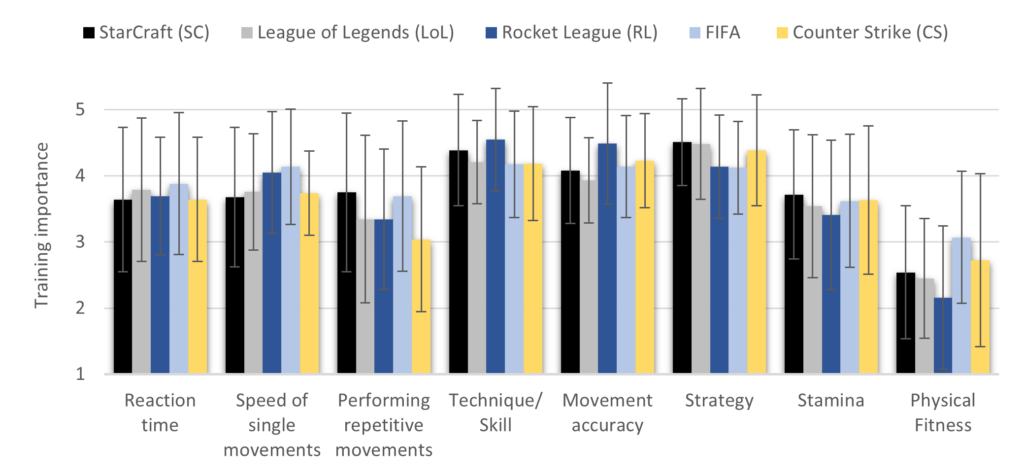
Interestingly, discrepancies were also found between the importance of training and the actual training engagement (Figure 3). The importance of strategy training was rated almost identically by StarCraft, Counter Strike and League of Legends players. However, there were differences in the training engagement. StarCraft and League of Legends players train strategic aspects significantly more often than Counter Strike players. Another striking example is the training frequency of Technique and Skill. While the differences between the esports were small when it comes to the importance of training technique and skill, the training frequency shows that Rocket League players work by far the most on their technique and skillful movements.
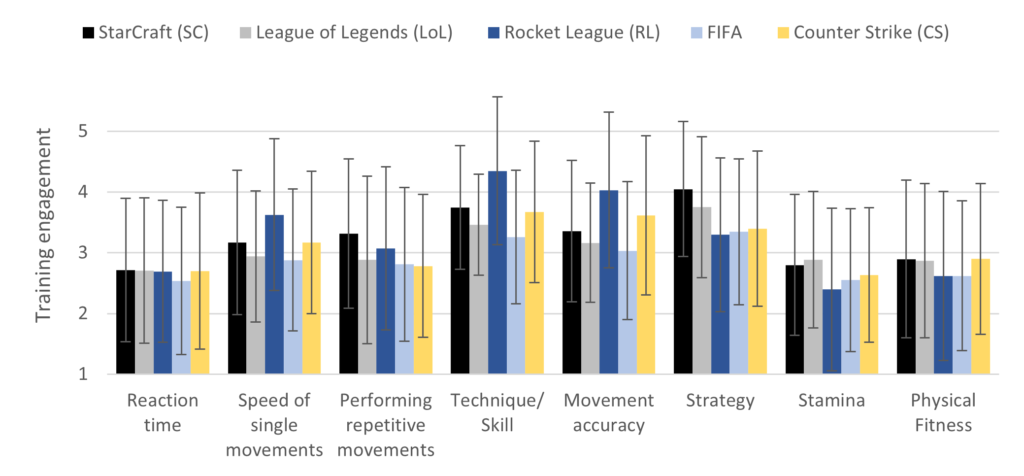
This discrepancy indicates that the training of the players may not be optimally adapted to the requirements of the games. According to the authors, one reason for the discrepancy could be the information sources of the players. Since esports is not structured like traditional sports, there are hardly any instances that develop training programs and thus enable them to be professionally supported. Players are therefore usually forced to obtain information from other players on the Internet. Only 2% of players get professional support for their training. While 84% use other players as a source of information for their training. For the authors, the statistics are an indication that professional promotion in esports has enormous potential and can improve in all areas. The training of esports athletes as well as their support and promotion will become more and more important in the future.
Conclusion
The study shows that esports can also be analyzed from a sports and training science perspective. In the future, it can be assumed that more and more specific training programs, inspired by traditional sports, will be developed for esports. Even if esports is different in a number of aspects, it should not underestimate the scientific advantage of traditional sports and training science and should instead use it to its own advantage. The more professional the esports becomes over time, the more important the role of training control and performance optimization becomes.
Sources
Nagorsky E, Wiemeyer J (2020) The structure of performance and training in esports. PLoS ONE 15(8): e0237584. https://doi.org/10.1371/journal.pone.0237584



